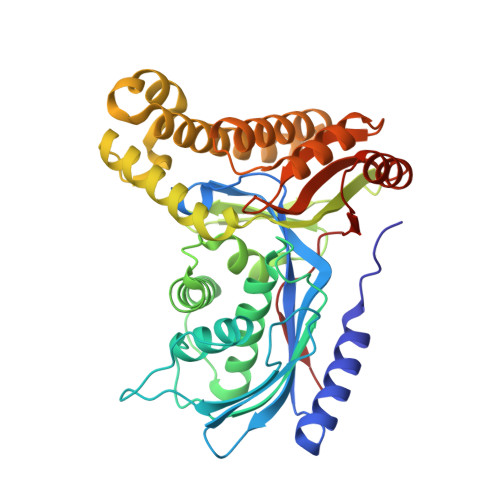Structure-Based Optimization of Small Molecule Human Galactokinase Inhibitors.
Liu, L., Tang, M., Pragani, R., Whitby, F.G., Zhang, Y.Q., Balakrishnan, B., Fang, Y., Karavadhi, S., Tao, D., LeClair, C.A., Hall, M.D., Marugan, J.J., Boxer, M., Shen, M., Hill, C.P., Lai, K., Patnaik, S.(2021) J Med Chem 64: 13551-13571
- PubMed: 34491744
- DOI: https://doi.org/10.1021/acs.jmedchem.1c00945
- Primary Citation of Related Structures:
7RCL, 7RCM, 7S49, 7S4C - PubMed Abstract:
Classic galactosemia is a rare disease caused by inherited deficiency of galactose-1 phosphate uridylyltransferase (GALT). Accumulation of galactose-1 phosphate (gal-1P) is thought to be the major cause of the chronic complications associated with this disease, which currently has no treatment. Inhibiting galactokinase (GALK1), the enzyme that generates galactose-1 phosphate, has been proposed as a novel strategy for treating classic galactosemia. Our previous work identified a highly selective unique dihydropyrimidine inhibitor against GALK1. With the determination of a co-crystal structure of this inhibitor with human GALK1, we initiated a structure-based structure-activity relationship (SAR) optimization campaign that yielded novel analogs with potent biochemical inhibition (IC 50 < 100 nM). Lead compounds were also able to prevent gal-1P accumulation in patient-derived cells at low micromolar concentrations and have pharmacokinetic properties suitable for evaluation in rodent models of galactosemia.
Organizational Affiliation:
National Center for Advancing Translational Sciences, National Institutes of Health, 9800 Medical Center Drive, Rockville, Maryland 20850, United States.


















